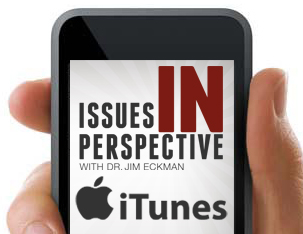Is There Evidence Of A Spiritual Revival?
Aug 2nd, 2025 | By Dr. Jim Eckman | Category: Culture & Wordview, Featured IssuesThe mission of Issues in Perspective is to provide thoughtful, historical and biblically-centered perspectives on current ethical and cultural issues.

To fully understand the development of American civilization, one must come to terms with the strategic role revivals have played. Colonial America was shaped and transformed by the First Great Awakening of the 1740s and the Methodist revival that followed. America of the early national period (1815-1850) was profoundly impacted by the Second Great Awakening. You cannot understand the energy for the abolition of slavery, the passion for women’s rights, the temperance movement and other social reform movements without coming to terms with this revival. The Laymen’s Prayer revival of the late 1850s began to transform America’s urban/commercial centers and the southern states of what would become the Confederacy. D.L. Moody led a spiritual awakening in the urban centers of America through his preaching and social reform work in the 1880-1890s. Billy Graham was the face of the awakening after World War II through his mass evangelism campaigns, which affected not only America but the entire world. Smaller awakening’s occurred in America that did not necessarily have a national impact (e.g., the Jesus Revolution of the 1960s and 1970s, the Brownsville, Florida revival of the late 1990s). Finally, the 1906 Azusa Street revival laid the foundation for Pentecostalism and later the Charismatic Renewal movement, both of which continue to influence American Christianity today.
Over the last several years I have been in numerous discussions about the possibility of a genuine, widespread spiritual awakening in America, even in the world. I have preached on this subject and have taught and written on the major revivals (“awakenings”) that have occurred in American history. So, it is appropriate to ask whether America is now experiencing a spiritual awakening, a revival. If so, what should we expect to see? What are the dimensions of a genuine revival?
For decades, America’s fastest-growing religious affiliation was no religion at all. In 1990 just 5% of Americans said they were atheists, agnostics or believed in “nothing in particular.” By 2019 some 30% ticked those boxes. Those who left the pews became more socially liberal, married later and had fewer children. Churches, where once half of Americans mingled every Sunday, faded in civic life. “Yet for the first time in half a century, the march of secularism has stopped.”
Lauren Jackson writes in the New York Times about the effects of secularization across American culture: “America’s secularization was an immense social transformation. Has it left us better off? People are unhappier than they’ve ever been and the country is in an epidemic of loneliness. It’s not just secularism that’s to blame, but those without religious affiliation in particular rank lower on key metrics of well-being. They feel less connected to others, less spiritually at peace and they experience less awe and gratitude regularly . . . Secularization is on pause in America, a study from Pew found this year. This is a major, generational shift. People are no longer leaving Christianity; other major religions are growing. Almost all Americans—92 percent of adults, both inside and outside of religion—say they hold some form of spiritual belief, in a god, human souls or spirits, an afterlife or something ‘beyond the natural world’ . . . But for now, secularism has not yet triumphed over religion. Instead, its limits in America may be exposed.”
What evidence does Jackson offer about the waning of secularism and this new embrace of spirituality?
- For the last few decades, much of the world has tried to go without God, a departure from most of recorded history. More than a billion people globally and about a third of Americans have tried to live without religion. Studies in recent years have offered insights into how that is going. “There is overwhelming empirical support for the value of being at a house of worship on a regular basis on all kinds of metrics—mental health, physical health, having more friends, being less lonely,” said Ryan Burge, a former pastor and a leading researcher on religious trends.
- Pew’s findings corroborate that idea: Actively religious people tend to report they are happier than people who don’t practice religion. Religious Americans are healthier, too. They are significantly less likely to be depressed or to die by suicide, alcoholism, cancer, cardiovascular illness or other causes. In a long-term study, doctors at Harvard found that women who attended religious services once a week were 33 percent less likely to die prematurely than women who never attended. That’s because, said Tyler J. VanderWeele, an author on the Harvard study, “they had higher levels of social support, better health behaviors and greater optimism about the future.”
- Religiously affiliated Americans are more likely to feel gratitude (by 23 percentage points), spiritual peace (by 27 points) and “a deep sense of connection with humanity” (by 15 points) regularly than people without a religious affiliation, researchers found this year. The latter is particularly important: Positive relationships are the single most important predictor of well-being, according to the longest-running study on human happiness in the world.
- Church attendance rates have been slipping for decades. But since the pandemic began, the number of people attending religious services—either in person or virtually—has remained consistent at about 40 percent. About a quarter of Americans told Pew that the pandemic had strengthened their existing faith. “Covid may have cemented or reinforced the importance of religion to people who were already religious,” said Alan Cooperman, an author of the Pew report.
- Religion provides what sociologists call the “three B’s”: belief, belonging and behaviors. It offers beliefs that supply answers to the tough questions of life. It gives people a place they feel they belong, a community where they are known. And it tells them how to behave, or at least what tenets should guide their action.
The Economist recently reported that the renewed interest in spirituality is not confined to the US only: “In Canada, Britain and France, the share of people telling pollsters they are irreligious has stopped growing. Across another seven western European countries it has slowed markedly, rising by just three percentage points since 2020, compared with a 14-point surge in the previous five years. The stall coincides with a pause in the long-term decline of the Christian share of the population in the same places. This suggests that slowing secularization is caused by fewer people leaving Christianity—rather than the growth of other faiths, such as Islam—alongside a surprising increase in Christian faith among younger people, particularly those from Generation Z (born between 1997 and 2012).”
The Economist also reasons that “The most plausible explanation for the changing trend is the covid-19 pandemic. Lockdowns, social isolation and economic shocks affected almost all countries and age cohorts at about the time that the data on religious belief hit an inflection point. This is especially the case for Gen Z, whose years of early adulthood were disrupted, leaving many young people lonely or depressed and looking for meaning. ‘The pandemic really was a catalyst’ for becoming religious, says Sarah, a 20-year-old student at Liberty University, who grew up outside the church but converted after joining a Bible-study group on Zoom during the lockdowns. ‘Probably over 75% of my friends who are Christians became Christian since the pandemic.’”
“In all 14 Western countries surveyed by Pew, a pollster, more people (often twice as many) said their faith was strengthened by the pandemic rather than weakened. More than a quarter of Americans had their faith fortified, says Gregory Smith, an expert in religion at Pew. Research by Jeanet Sinding Bentzen, an economist at the University of Copenhagen, shows internet searches for prayer and other religious practices shot up in almost every country in 2020. Pippa Norris of Harvard and the late Ronald Inglehart argued that in times of existential insecurity, people tend to turn to religion for comfort. Religion can explain suffering, offer hope and provide a sense of moral order and communal solidarity, they wrote. Religious attendance (often online) increased in Italy in 2020, particularly in places hardest hit by the virus. Ms. Bentzen’s previous research on devotion following earthquakes—a different sort of shock—shows that religiosity tends to remain elevated for up to 12 years after a catastrophic event.”
Consider these other pieces of evidence:
- Between 2020 and 2024 the share of Christians in the population as a whole fell by just one percentage point. Before then, it had been dropping by that much every year. Look more closely at each generation and the Christian share either held steady or increased over the four years across all age groups except millennials. Baby boomers, for example, were seven points more Christian (at 79%) than they were in 2020. Taken together, the slowdown in religious exits across several generations and the unexpected rise among the young have caused the Christian share of America’s population to stabilize at around 62% since 2020.
- Spain, Portugal, Italy and Finland, among others, are no less Christian today than they were in 2019, according to our analysis of large European surveys. Some countries, such as Austria and Ireland, are still becoming less Christian, but at a slower rate than before. The share of people in the West who told Gallup that religion was important in their daily lives steadily declined between 2006 and 2019. But over the past five years this figure has stabilized. In Ireland, for instance, 58% said religion mattered in daily life two decades ago; by 2018, that figure was 48%, and has remained there since.
- Active withdrawals from the Church of Sweden have fallen for the past five years, and baptisms among young adults have more than doubled since 2019, notes Andreas Sandberg, its record-keeper. Our analysis of the British Election Survey shows both the secular and Christian share of the population have been flat since 2020. More interesting is that the irreligious share of Gen Zs has fallen every year over the same period.
- Adult baptisms in France at Easter this year jumped by 45% to more than 10,000, the most in 20 years. Two in every five of these were Gen Zs, double the share in 2019. Baptisms in Austria and Belgium also rose. In 2023, the last year for which data are available, converts to the Church of Norway doubled to 4,000.
As a historian, I have studied the various revivals throughout history, especially those within the American context. One conclusion is certain from my study: Revivals are the sovereign work of God’s Spirit and it is not wise to predict what God is doing. Therefore, it is too early to draw any significant conclusions from the data and observations cited in this edition of Issues. But this much is clear: The bankruptcy of secularism is evident and people are seeking meaning and purpose through the spiritual life. That is certainly an indicator of God’s Spirit at work.
See Lauren Jackson in the New York Times (20 April 2025); and The Economist (14 June 2025 and 19 April 2025).


